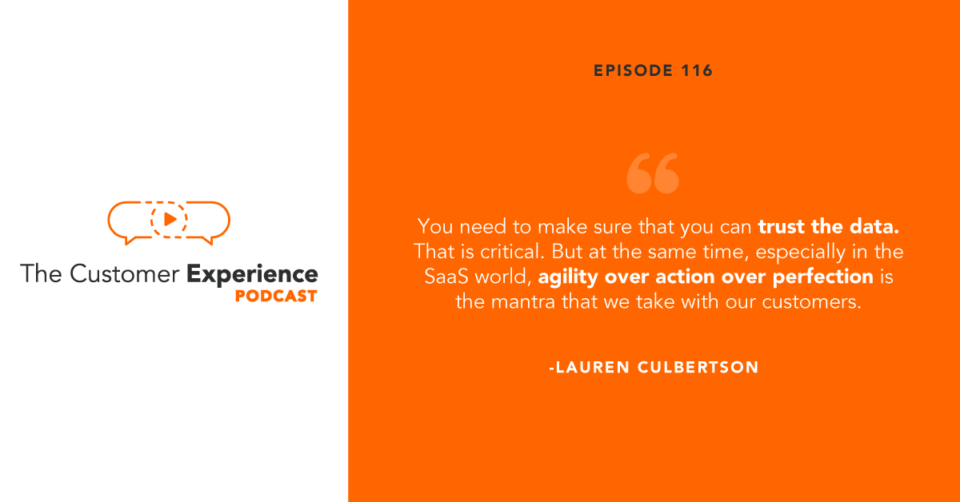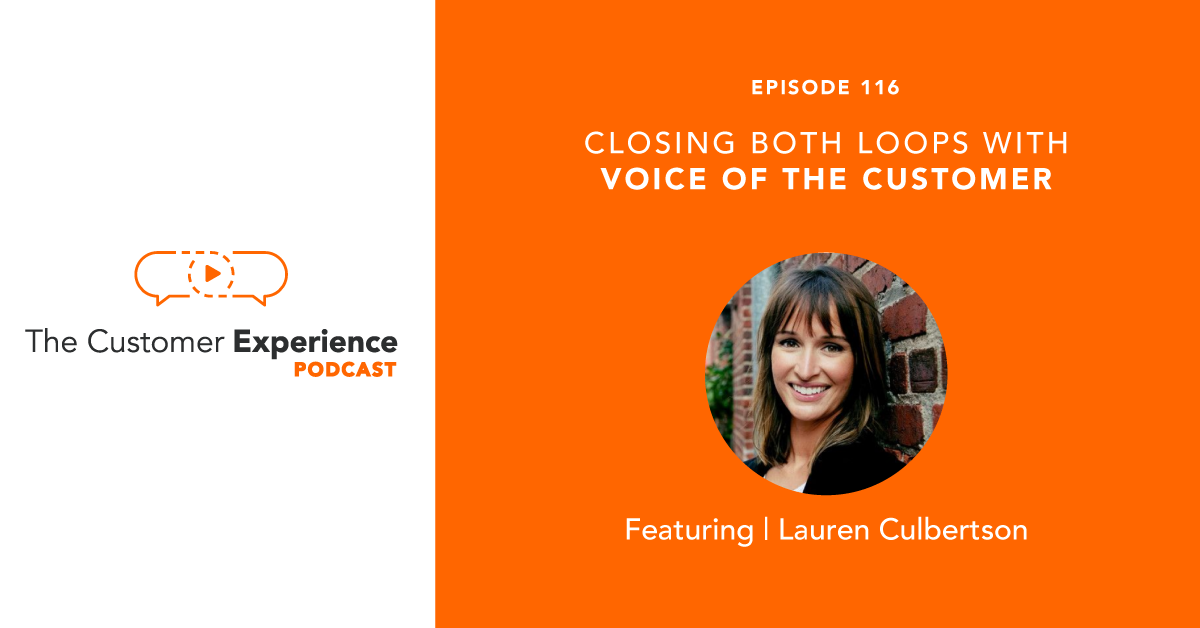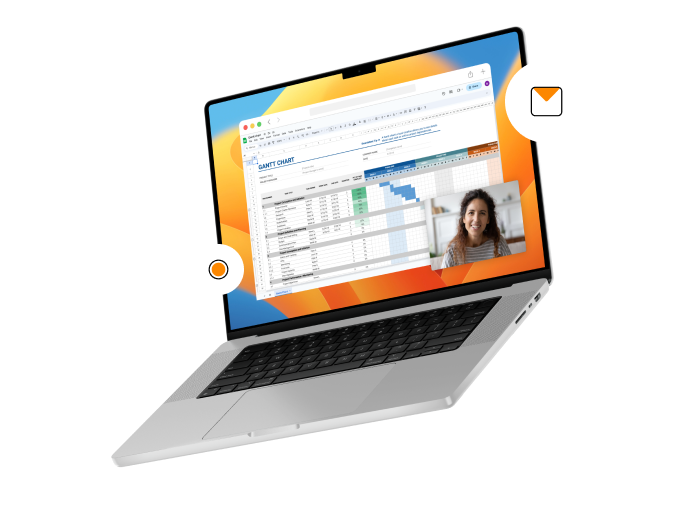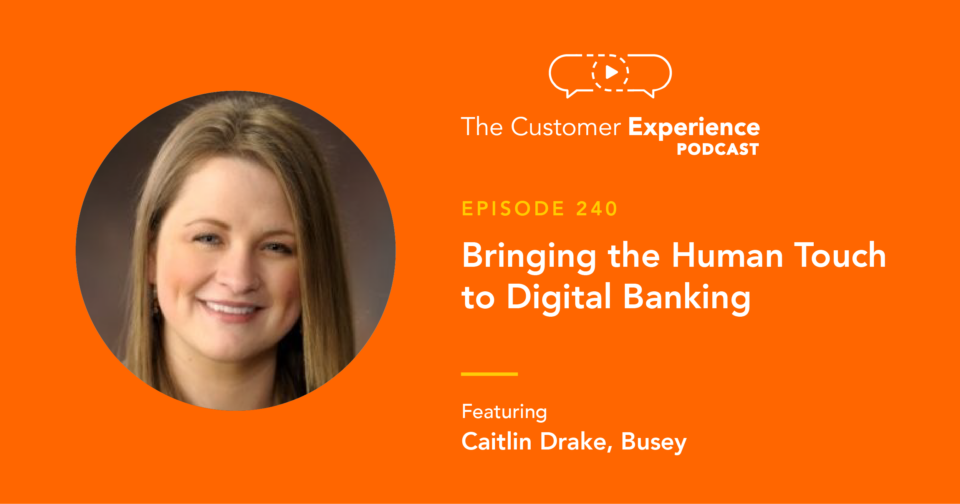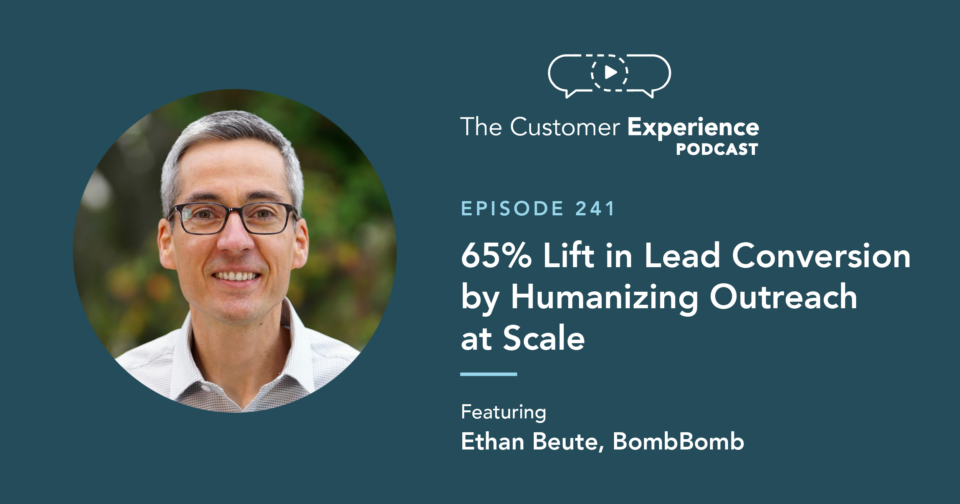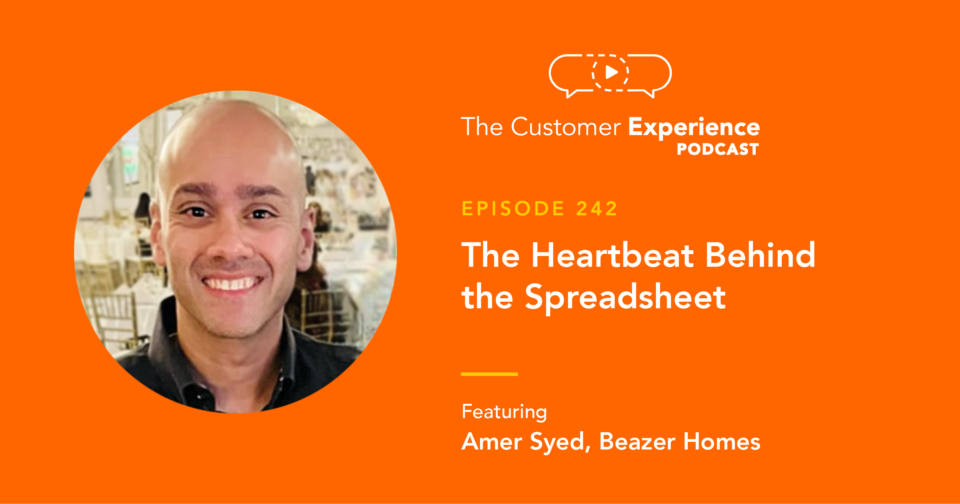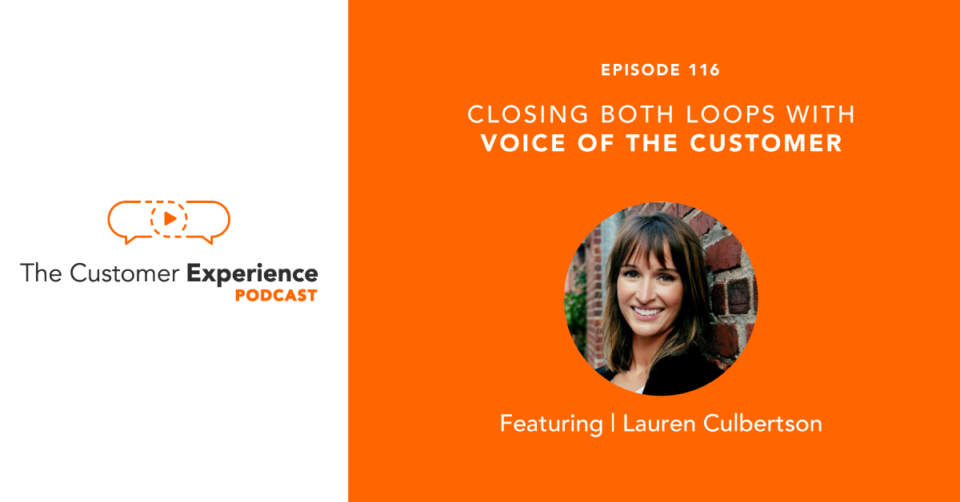
Listen to “116. Closing Both Loops with Voice of the Customer w/ Lauren Culbertson” on Spreaker.
Apple Podcasts | Google Podcasts | Stitcher | Spotify
One of the jobs of Customer Success (CS) is to close the little loop — to answer a customer’s question or to solve her or his problem. But it’s the role of product marketing, customer experience, or another team to close the big loop and adapt company strategy by listening to and acting on the voice of the customer (VoC).
The tension between these two loops can arrive when we assume that assigned responsibility for the little loops also closes the big ones. It’s also a big, missed opportunity for your company.
Actually acting on the customer’s feedback is where most companies fail. Only about 5% of organizations are currently in the action phase of responding to feedback and closing the big loop of customer expectations, aversions, mindsets, preferences, and more. Why are nearly all companies missing their customers’ deeper needs and constructive ideas? THe problem starts with how a company collects, organizes, displays, and accesses the feedback and the problem proceeds with how decisions are subsequently made at a company.
Lauren Culbertson, Co-founder and CEO at LoopVOC, was haunted by the unheard voice of the customer and the overlooked themes that were coming out of their feedback. Now, she builds market intelligence and VoC software to help companies unify their teams around the customer.
In this conversation, Lauren teaches us…
• Why CX has so much to do with brand
• What voice of the customer is (and isn’t)
• How the two loops are defined and how to close them
• What three data sets to take into account
• Where to position VoC in your org
Closing Both Loops With Voice of the Customer
Take this episode of The Customer Experience Podcast anywhere you go in your preferred podcast app:
When you visit, please give an extra click to review the show — it’s very helpful. Of course, you can also subscribe and/or write a review,
We embed these episodes in these blog posts, as well.
Listen to the entire conversation with Lauren Culbertson of LoopVOC right here:
Listen to “116. Closing Both Loops with Voice of the Customer w/ Lauren Culbertson” on Spreaker.
Sign up for a monthly email with CX insights and highlights
By entering your email, you are agreeing to receive occasional BombBomb news and communication. We will never sell or distribute your email address to any third party. You can manage your communication preferences here.
View our Privacy Policy.
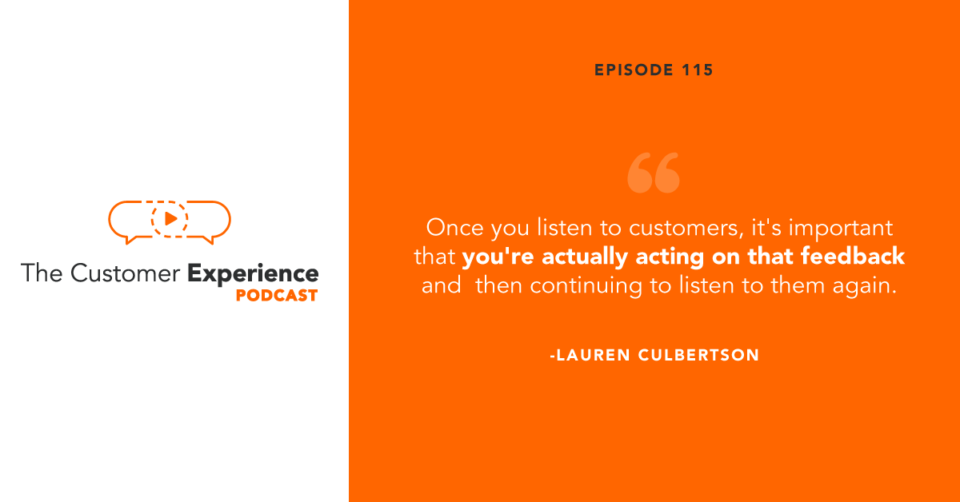
Video Highlights: Closing Both Loops With Voice of the Customer
Check out the top five video highlights from the discussion with Lauren Culbertson of LoopVOC below…
1. Definition of Customer Experience
2. What Voice of the Customer Is (and Isn’t)
3. Little and Big Loops
4. Three Data Sets To Start With
5. Where VoC Belongs In Your Org
Full Transcript: Closing Both Loops with Voice of the Customer
(This is an automatically-generated transcript. You can also search for keywords directly in the embedded podcast player in this post.)
You need to make sure that you can trust the data that is critical, but at the same time you know this. This kind of movement towards agility, and especially in the fast world agility over action of a perfection, is really the Monstra that we take with our customers. The single most important thing you can do today is to create and deliver a better experience for your customers, learn how sales marketing and customer success experts create internal alignment, achieved desired outcomes and exceed customer expectations in a personal and human way. This is the customer experience podcast. Here’s your host Eatan Beaute, using customer feedback to drive better business decisions that seems foundational to a better customer experience and better outcomes for everyone right. Well, that’s what today’s guest in her team are focused on every single day, she’s been seven and a half years at blackbought in sales, marketing, ops and product marketing roles. Today, she’s cofounder and CEO of loop voc, where her team builds market, intelligence and Voice of the customer software to help companies unify their teams around the customer. Lauren culbertson welcome to the customer experience podcast. Yes, thanks! So much for having me here then yeah, I’m really excited for the conversation. I love what you’re up to your solving a legitimate challenge that anyone spending time in service of the customer thinking about it working on it has encountered before. So I’m really excited to share your story of the kind of the motivation to found the company, but before we get into it really quick, you ow, you did your Undergrad at Clemson in their school of business and you did an NBA, UNC, Chapel Hill talk about that master’s degree. Experience from a customers perspective. How was it di e meet expectations to ecceed expectations? How has it srved you it’s Enyo aske about that, because I was just spending the weekend in Ralih, which is right by Capalo and Durham, so I was reflecting on it a bit actually so good yeah, but you know I chose to do and nontraditional program, so I did an executive program and that allowed me to continue kind of my work at Black Bod and also go to a school that was beyond what I could go to. If I just stayed local in Charleston. There’s not as many options and so really what I’ve wanted to get out of the program was exposure to other leaders, kind of understanding more about. If I want to take the leaf in introneurship by you, know, sharpeting my skills where I might be weaker and and yeah just really learning from leaders from different places. Bus is what an executive Rogram I can do and all those things were absolutely met. I am one of their. You know a very happy customer they’ve had me: Do Promotion Videos so I’m probably on their tream. I’m definitely a promoter, but but yeah really great experience. I love it and it really. I mean you just kind of an underlying theme that I just picked up. There, of course, is something that I think we all experience when we have a good customer experience, which is the relationships with all the people involved from you know, in this case your fellow customers, the service providers and the people and support of the entire experience. I’m glad you’re, just reflecting on that Yeahso. Let’s go really high level customer experience when I say that to you larn: What does it mean? What does it conjure? What comes to mind yeah, so I was relocking on this a little bit today and to me customer experience has so much to do with brand and I think, that’s often very overlooked. We a lot of time, see it as operational and when you first ask that question. What comes to mind is like. Oh, it’s, the sum of all the touchpoints of an activity that are company has of with customers, but really that’s so transactional, and what customer experience is to me. It’s how a customer gets value from your Briand, and that starts at the very beginning of the first interaction. They ever see a social post that they might see how sales is setting expectations in the sales process a lot of times. We start thinking about customer experience when someone becomes a customer, but a lot of times forget about why how their expectations were even set in the first place, which of course, satisfaction like you already mentioned. Is You know what expectations did you sai with them and were they exceeded, or did you fall short and expectations are usually set in the beginning in sales process? So to me, it’s that whole brand experience of how you’r positioning value and then how you’re actually delivering on it, love it so, obviously an important if we are going to pay attention to it, work on it, improve it crossfunctionally etce, then we’re going to be talking about voice of customer, and so obviously that’s the VOC and loop voc so give us a quick whether you want to take it as a definition or something else for folks that aren’t very familiar with the term. Maybe they’ve heard it but they’re not. You know in a team that focuses on it or uses it often what is voice of customer and perhaps what is its relationship to customer experience? I’ll tell you a voice of customer is not first boy of customer is not surveys so a lot of times when people think about voycs of the customer. They think the box is checked because they send out a survey or even a bunch of surveys that ask how are we doing, even if it’s NPS understanding what customers need from them? Moways of the customer is a lot more corvermatic than that and really a lot more embetted in how you are naturally doing business with your customers, and so it means listening to places where they’re already getting the feedback. So I think I voices customer kind of three steps and it’s almost more of a hierarchy, because the last one is the hardest to get to so the first step is just listening or feedback collection and that can be from servies absolutely are still a good channel, but it also is making sure that you are listening when things come up in sales calls there’s great tools like Gong. That can make that even easier. It is taking feedback that youere, seeing in allmine terviews and social media. It’s looking at NPS, it’s looking at. We loss data and how sales reps are saying, they’re, losing deals and also Hou. Customers are saying why they’re churking so that Kee, that collection is critical and then it’s then analysis of okay. What are the themes coming out of that peet back data, so this is really where our Ur strength. What are we doing really? Well, where our weaknesses? What do we need to maybe improve? Looking at how feeback they’re giving could be impacting your performance? So true, if your pestomer are saying we left because of this. Obviously that could have a higher impact than someone who is giving you more constructive criticism, but it might not be actually driving your business in a certain direction and then once you understand that, of course, the Pinnacle is action, and that is the hardest to get to. I someone told me the other day that there was a qualltrix report that show that only five percent of companies are in the action phase is actually, I think one of our companies we work with is poral site and they have an amazing forces. A customer program- that’s really advanced to GIV in their size, but hhe. Let me know about that. Five percent tat on five percent or on the action phase, and that’s actually doing something about those weaknesses and opportunities that you say Gan that takes us back to where you started with the question and it’s so health budes protip for anyone doing any work of any kind when you are in a definitional situation, defining something in part by what it’s not as very, very helpful, and so that that five percent number reminds we wee restarted with this. It’s not just the survey check the box. Congratulations were done. I feel, like I pulled some of this forward by asking that question right after customer experience, but for folks, Wyou Aren’ familiar tell us a little bit about loop voc like who’s your ideal customer, and what are you solving for them? Yes, so luthe CE is a voice of the customer and voicees the market platform. So we work with btbsass companies that are in the startup to midsize business rane. Usually our customers have between two hundred and five zand employees, and we really help with really providing technology to make that voice of the customer process more strewe lined. So we integrate into channels where a lot of times, speed bats, are reabing stored, like sales force for notes from sales conversations or cussmo success conversations survey tools for the feedback. That’s coming from a lot of these customer experience, surveys like net promoter score or even csat or CS, and then we also crawl the web for places where customers are getting feedback on the Internet like online reviews or social media, and we use natirally mach processing, which is a formof mchine learning to scan through all that text and identify the key themes that are coming out of it. So you can understand the action that you should take. So, for example, you know a customer could see that over a certain period of time, there’d been more complaints about how long it took to get any as er firm support, and then they be able to actually shift their support strategy to better meet those needs, and that example is actually an example of one of hour. Customers that they had was able to maunch chat support, just based on understanding how their customer needs have changed, even though their average responsetime was staying. The same so they’re Hanning, the Quantita of Gol, but the qualitated data that comes out of feedback can help you understand when your own goals might be off. Based on what customer Le Really Good. I think we’re going to get probably deeper into several of the things that you drove by there, but before we do we’ve already desfined voice of customer, which is the VOC part of Lop Poc, I feel like. Is there something about the customer feedback loop and listening and analyzing and acting t is? Is that part of the loop in N, the company’s name? And how did you arrive that it just kind of for fun? Yeah loop is the when you ere, when you achieve the pinnacle of closing the Loob Shifting Your company strategies that is penof closing the lip. So loop is kind of a play on the fact that you know once you listen to customers, it’s important that you’re actually acting on that feedback and then continuing to listen to them again, because Wuest strategy is’ only going to say relevant for so long. I think it’s really interesting since ielanchli was actually two years ago. Last week that I oragually Atonslin ye tank, you, I think a lot of times. Companies will think about the the little loop whut ie hoad, the little loop, which is following up with an individual customer to say we resolve this problem or making sure that they’re satisfied, but a lot of times we don’t close the bigger loop, which is actually changing company Strategis US saying, okay, we are actually going to act on this information by changing our crising or changing our product, Roa back or shifting to a new support model, and then obviously the loop has to be closed on a group EER scale, because you’re actually impacting a huge thing of your customers. The loop and LUV VC is is all about the action. and honestly, I can’t even remember it you just like. I think I just like woke up and was like loop and it just made sormuc sense. I love it n and the really cool nuance. You’ve added here is that big loop piece. I because you know I’m just thinking about the work that we do here a bombomb and certainly we’re pretty aggressive about closing the little loops, especially extreme, positive and extreme negative, but but that big loop is something that is, you know, becomes operational and it transcends any of that and it gets ahead of so many like you have to. I would assume that if you start to do this very very well that there’s fewer small loops opened because you’re addressing the bigger loop, that’s actually a point. Yes, one hundred percent. I know I know a little bit about your founding story, but I would love to hear it because you are like so many of the guests on the show where you are solving a problem that you had yourself in a previous role and so the way you defined voice of customer and introduced who loop Vioc is, I think, gets at it. But let’s get one layer deeper like where were you? What were you up against and how did this opportunity to bring everything together, Amerge for you enough, so that, while you’re in thes entrepreurship program at UNC, Chapel Hill, you say I’m going to go. Do this just I’ll start off just in general, I think a lot of entrepreneurs have that brain where they have consantly have ideas, and so ive talke to many enginers that have like an idea book where you know they have companies that can start, and I’ve talked to also people that are on that fense of wanting to be an entrepreneur, but being too afraid to make the jump. CICH is the hardest part is saying: okay, I’m Goinna give up my nice corprate salary and just go onin with this thing that probably won’t work like based on statistics but with Luk the that’st who thing o describe it. Is it just? Was it haunted me? The problem haunted me. I could not shake it. I could it wouldn’t Leav me. It haunted me for seven years. So when I started at Blackbod, I was in sales. I was a BDR and I was talking to customers every day. Seen Er making sixty guys a day, I d get on the phone with twenty of them. One would become a lead. Even then, it was really interesting to me, there’s so much process for that one leade that I would get what they needed, how we can help them. What theyere going through there’s no process for those nineteen calls that I talked to, but didn’t want to do business with us and they were telling me things like competitors are prising you out of market. This company over here is developing a feature that better serves my market needs. You know, here’s where I’m I’ve heard bad things about you, and it was really you know kind of porplexing to me. So I became very interested in how decisions were made at a company. How did the company decide when they should shik their strategy, and I found that marketing was a big place where thos kind of decisions were being made, and so I wanted to go in marketing, because this was interesting. I and when I went in the marketing I’ found that the way the decisions were being made, which is very common for a lot of companies, especially one that was black bod size, was doing one or two surveys a year spending a lot of money waiting six months for those results to be analyzed and then saying: okay, Yous, what we’re going to do for the year ECAUERE. We need to build the product for this segment, who I e need to change positioning. We might want to do some repricing. Let’s pick off our annual plan, hey, maybe youdon’t even me, tire to a three year plan. It just was not leverging any of those insights that we were getting on the front line every day and I think that’s another important part of VC is like your frontline people. You have to empower and trust that they are good source entelt, but I got the opportunity to actually change some of that when the company was moving from being an on prem legacy software company to be assass company because suddenly was like okay well now, there’s something called subscription revenue and something called retention. Yeah, we’re going to need to be a little more agile in how we’re delivering value, and it’s very common to think about that or the product perspective, because you have Adal Rod, maps and no longer. Is it a waterfall once a year, approachd rolling out features it’s you know every day, even but people weren’ thinking about that from a positioning, ind, a go to market perspective or even a customer experience perspective, and so I got to kind of create a process where, once a week, we would meet with executive leadership, and I would present the key themes that were coming out of feedback from customers prospects in the market. What that looked like on the back end was every Tuesday I would meet with representation from sales customer success, legal fience, marketing product any function. You know of the customer experience and we would talk about what are the key themes, we’re hearing from customers and prospects in terms of what’s going well, what’s not going well. How is that tired to revenue? And what do we want to bring up as in terms of actions that made me taken to hit our numbers? We present that to the cease weet every Thursday, every Thursday decisions were made every Thursday we would say, okay, you know head of alrredo. What are we doing to solve this in Canada? Okay, we’re going to pivot, and this was a company T at was known. Like we’re thirty years old, we were no verbeing, a dinosaur like not Itoi, but because the seasmeet actually was connected to quantifiable trends of here’s. What we need to do to hit our numbers based on what cusword need we could move so much faster and it was really also inspiring to the front line employees to because they were being listened to, and then they were little clotes, more deals or retain more customers, and I was really powerful and I think what really it stood out to me was just how it changed the culture of the company just to be so positive, and obviously our customers during that time like and if you look at blackbod stock price. During that time, I as like two thousand and fourteen, when we moved to the cloud and we’re having these meetings like it, is very line with Wer. You could tell we’re meeting their needs. You know. Obviously that process I describe is a lot of work. Reading through thousands of pieces of text sales force, notes, SRM that it was hard to maintain and expensive to maintain and the only options hat were out there. These big companies like Qall tricks, which are great for enterprise companies, but a lot of times. You Know Small Gartrmens, get board that, and so again I come back to like there’s problem and I just kept thinking about if there was some sort of way for there to be this repository where technology yo could automate that and even like started talking about it. Ias like Oh, we need like a Lut, we need loop and, if theeers like Oh yeah, we need loop and then, when I was at TNC, I was taking thei trick to Denmark and I was visiting an accelerator and this engineer came up. Penny couldn’t speak, barely any English actually because he was from Germany, he was presenting natural lagage processing and it was bucketing together these Li worvs that weren’t the same word, but it was basically contexturalizing themes coming out of text, and I thought this is the future. This is lue. This is look, and so I was immediately googling everything I goold about naturally wish processing deep learning ai very quickly knew I would never know enough. So I came back hired a view. Data scientists on the side to run models on texual data to see if it could even be close after about a year. Ias like okay, this cand work and then went on right. That was a really long but fascinating to me. It’s so wonderful an and it reaffirms to me something that I believe is very very true, and I think we just go to like just generically speaking ai right, like Ai, is not useful unless you have very large Dataset and humans that truly understand the problem and I’ve had like their hands in it and they’ve worked through it and it’s a struggle and all the stuff like you went, you did I so much of the the An the other folks you’re working with so much of the heavy human lift to truly understand it, so that you’re not just building or throwing software solutions and hardware solutions at a problem, but instead you’re truly solving it from from a deep understan’s. A fantastic story really really enjoyed it and it I’s obviously a lot more detail that I had before from a let’s now, let’s just bring it back to the listener here. So maybe there’s someone doing a similar role, as you were at black bod, where someone’s running around and collecting things and sharing things and telling things and organizing information run. That down for folks like what are some of the the primary like when you, let’s say, let’s say loop on boards, a new customer. What are the? What are the five to ten most Coren? I’m making that number up? How many useful data sources does your average new customer have and what are some of those channels or sources. You’ve already mentioned a couple, but let’slet kind of boil those down really in one spot. This is important because a lot of times companies will get really focused on having a perfect dataset that is weigted and removes all bias and are thinking about it from a very market research standpoint and absolutely you need to make sure that you can trust the data that is critical, but at the same time, this kind of movement towards agility, and especially in this ass world agility over action of a perfection, is really the Montra that we take with our customers and that what I’ve seen even those companies that aren’t our customers and are the most forward thinking in their vc or doling. And so, when you think about the Datasets, you want to start with. I usually like to start with NBS, because most bbbcass companies are doing that already. It’s a great wage t also add some quantification beyond just frequency, because you have a score and you can tie that with centement analysis to say: okay, what is the impact on our NBS or if we were to make a change? The second is online views, which is often controversial when I’m talking to Casmishpo for at first, because I think online reviews are a oftentime. sphought of outside of marketing is marketing fluff. But if I force someone to actually read Ar Review they’re like Oh wow, this person’s, like giving us Criticisi’m like yeah they’re, giving like they have to it’s part of the question, and so it’s not just a gelp review like a review that comes from I’d, say: Gt, crowd, Captera Trust, radius, interest pilot ar the most vewse that I’ve seen in the BB SAS space. There’s really really valuable data. That’s coming out of that, and it gives you a datapoint from a different stage of your customor lifetycle. The other I’d say like this is, would be like a well rounded three NPS online reviews and then sales force notes either coming from deals that are one and loss that are coming from customer successing. why O customer left- and I think this is important because it forces the program from the beginning to incorporate not just direct trem, the customer Beeback, but also it says, I’m trusting the speedback coming from my frentline teams, because they are the connection to the customer and we can get more feedback from their interactions than we can bombarding every single customer to get us to be back all the time. So so this are that’s the three h wonts at Starcoris really good. How do you intersect, or do you intersect that data with things like product usage data? However, the company is segmenting their customer Bays, perhaps lifetime value, etcetera? You know you already reference like. Let’s take this information and not just solve problems, but also project impacts of things, so I assume that you’re intersecting this with different customer types, lifetime value etce. What’s the bridge that one hundred percent segmentation is huge and that’s actually been, our primary focus for this year has been continuing to evolve, that functionality so that I just actually posted about need space, egmentation, going int, O two thousand and twenty one, and really looking at all of that kind of phormographic or denographic of your BBC Data about your company and the segments you’re building out, but also segmenting on customers. That might not look like, but they have the same needs, and so you could position in them se in the same way. But a lot of that is already pulled into loot because we integrate with things like SAMs forse whichill often hold a lot of that data. Also like places like segment that are storing a lot of signetation data. The thing that were were thinking more and more about, and is we don’t have a great perfect ancwer foryet, but I imagine it’s probably. An intigration of some type is really bridging the usea product I egeta especially for product like groth companies and the quality of data, and you see a lot of companies like Pendo. For example, they have an MPs in their ACP, and so you can see the analysis of the text with all the other metrics, but getting beyond just that NPS survey and then also looking at the quantitative, that’s coming from. You know, product usage a lot of times. Companies are kind of matching that up or putting it together in like Metabolo, but there’s not a perfect answer for that one. Yet I think that’s that’s the future yeah good what’, it’s comforting for me to hear is we try like make all of our stuff connect and tell better stories to help people were effective that that’s still not fully in a lot of the loops that a lot of customers are challenged within working on? Where does this live a lot of organizations? I can see this being an initiative out of CS. I can definitely see it coming out of marketing in your story, of course, is marketing and product marketing, in particular with a little bit of marketing, APPs flavor to it by WHO’s, having most of the conversations as potential customers with loop and or in an onboarding process like who’s at the table. It feels like this transcends every team. That’s e Allenge that you’re solving is this is bigger than anyone team, so it has never been solved effectively before like who ha Ese people at the table like who’s the primary driver. What does this look like inside an organization? Yeah? It’s a great question. This has been the key like the the K challenge, an opportunity I would say of our journey defining product market fit as a startup. Obviously, so I think I mentioned yeah. I have a product marpeting background and I wore that hat at Blackbod, because there isn’ the hat of voice, is a customer manager whatever you want to call it because being a company that was just moving Aass like we didn’t, have a a customer experience team at the time and so wewere just kind of pulling people off. I think product marketing is a great role to kind of take charge on an effort like this, because they do already sit between so many functions. But that said, when you talk about yourself being a voice at the customer platform, everyone is immediately going to think customer success and when we are first talking to questiomer like launching in the market, customer successor were who came to us and I’ve learned a lot about. You know customer succession leadership over the past two years. The challenges that customer success is not customer experimence and a lot of times. It’s thought of that way. But we talked about big loops and little loops. Customer success has a little loop that they are humbled to solve, and so that is ar prarty number one. There will lose their job if they don’t solve that, and so a lot of times they closing that bigger loop comes second and so a tool like loop is almost a nice to have for them, because we’re not help we’re not gating, say we’re not helping them. You know cree to have customer health score and help them solve that fum with that cusmer. At that time, we’re oing them say: Hey, take this to the CEO and show him that you are going to lose twenty percent of this segment of customers. If you don’t shift your pricing strategy to be more inlined with what they’re needing and I’v found that there’s really not a standard forfet loans that in a company, but the best approach is having to your point- The keyplayers come together, which is marketing product and customer success. Those to me, if you don’t, have a customer experience team. Those are thesers that are in looped they’re, like all at was every single one of our customers. Those afunctions are represented, and I think that’s what is represented by strong DC program, love it and I’m sure it winds up. You know you get everyone at the table, I’m sure when she raises her hand- or he raises his hand in different companies that you wind up, probably with different rules leading in implementation like this. Are you seeing have you o mean, I guess, even in the two years or in your career in general arewhere? Do you think we are in terms of having operationalized CX with CX teams and CX titles, especially you know where you’re spending a lot of your time now, which is be to be Sass? Is it ten percent of the conversations this is represented? Is it s at twenty? Two is at seventy five. You have any thoughts on that or observations. I was very surprised with how how far we have to go as an industry with CX, because I think if you were just an outsider, looking at like your linkedin feed, you’d be like wow all these cutting edge, CX themes like this is amazing, everyone’s so far along but like when you actually get in and talk to most companies like they’re figuring it out, they’re figuring out things like. Where should this live theyare they launched to CEX team, but they found mistakes with maybe putting it in the wrong place or making it too broad or not, giving the wole the empowerment that they need actually drive decisions. You know I’ve read some articles that make a lot of sense to me, which ist like the Co should be the head of CX. But then, if the CEO is a product driven person, they’re not going to be giving that CX, the Importan senit needs, and so you know that was another key challenge with starting loop was. I went into it thinking ia working at at a very legacy company, like surely everyone else in the inustry was already doing this. We were just going to make it faster and more hortible, but really it’s a new. It’s a new category and it’s your point earlier. It involves so much collaboration like it involves really working together around a common goal, and that is why CEO involvement really there’s no way around that in the beginning like if you on’t want to see you that’s making this a priority. I just don’t think it can work. I’m curious your thoughts on it yeah it’s interesting. I see a lot of CX coming out of CS if it’s being like acted on or operationalized anyway, I’m certainly seeing more CX titles, but those titles mean the same variation. I mean some of them are legit like you go solve this, tell us what you need. We need to do this better, get everybody in a room and do it regularly enough, so that we can make some kind of an operationalized sense of progress here, but then also, I see just CX being slapped on what is a CS role, just straight up I’s, definitely postsale, it’s very clearly traditionally cs by definition and honestly, one of the one of the ways that I got bying. The variety of reasons that that my team supports me having conversations like these and publishing them and spending time doing it, which is an absolute joy and privilege, is that these are. You know a lot of the questions I ask here in our conversation Lauren, but also the you know, hundred and whatever that came before it. I’m asking questions on behalf of our own organization, because you know we have a lot of the same challenges as we’ve already talked around, which is we have a lot of different sources of data. The product team is looking at Tableau reports that they’ve put together with product usage data, but it doesn’t totally intersect with what the finance team is saying in terms of trends and segmentation in terms of conversion rates, lifetime value et Cetra, various conversion rates, mind you and then you know we do a pretty good jobs, an executive leadership team of bringing in CS team members into our weekly meetings, bringing sales people into our weekly meetings. Deas one deals lost themes that are happening out there, and so so we’re good at doing a lot of it. But you know to the challenge you set out to solve with Loub. It doesn’t all live in one place and the stories are a bit disparate and sometimes they conflict with each other. I’m thinking of one segment in particular one of the things I look at and I’ll give it back to you for whatever observations you have about what I share. You know a particular customer segment of ours. I like to look at our customers in terms of how many videos they’re sending, if you send a thousand videos or three osand videos or fivezard videos. You’ve clearly identified a lot of use cases and you’re using the product in the spirit in which it was intended, which is to replace some of what would otherwise be teked out emails or type out linked in messages or whatever right. It’s cool. If you, if you’re for your customer and you send one video a month to all of your customers, but frankly, you could do that with male chimp and Youtube, or you know whistea and constant contact or whatever like we that’s. You could do that with us, but that’s not what we’re trying to do so, I’m looking for customers using the product in really interesting ways and then getting to know them, and why did you send your two thousand seven hundred and eighty fourth, video and understanding them and what their business looks like etcetera, some doing that over years, ihave pretty clear picture. So I’m looking at this particular segment and they’re dramatically overrepresented in terms of accounts that have sent fivesand videos or more it’s like fourx, their representation and the customer population overall. But our CFO is looking at that same segment from his seat and goes like this segment is not very good for us and I’m looking at this segment going this segment’s amazing, and so it’s like there’s a truth in between their somewhere mean really that you can start to pursue that as a question. But we all see the customer a little bit differently. A salesperson definitely sees a prospect differently than an onboarding manager sees a new customer. They just see that person differently period, so I think we all see the customer differently. So this organizing it and allowing everyone to operate a little bit more from the same story, lines and themes and trends and things that are changing is just so useful, so useful, and that is such a great example that we just gave of silos. Unfortunately, but even if you were working together, which just seems like you were, because you even got the data to know that you know youas looking at different way like reframing it, as all of this data can tell us a story, and I don’t know I’ve been thinking a lot about data, not just because you know Livs, a data company, but also just our current world is it’s it’s very easy to get pulled into what data says from certain reports. But data can be read anyway, that you want it to right. It’s it’s biased with how it’s analyzed and even with machine learning machines learn from humans. So the collaboration year comes in again is: Can we get all the right people in ou room to have a discussion, I’m sure the CFO? You know I ws just doing a segnontation to exercise myself where we found a similar problem. Our highest customers o the highest adoption that we’re hitting like the key value metrics that we set up hic could be similar to the amount of video scent were also had our highest a position costs they just didn’t, and so what we ended up doing was what is the break even point where we actually are a cost of acquisition becomes worth getting. Those customers that are adopting us today. Is it increasing how much they’re paying us because they’re seeing a lot of value, and so then they actually become a really valuable customer in our cos za be, or is it trying to take out some of the cost from how much it takes to require, then by providing value in a new cannel and not relying on calling all of them? I think it’s hard to get every decision maker at a company in a room, but that’s where, like imbedding it in part of like your weekly or monthly leadership meetings, the voice of the customer and Frestiomar experience is so critical, justs, even just knowing other points of view and like what other functions are looking at. So your cofounder, how many other cofounders and two other cofounders we have fary is our technical, cofounder and R CCO and then Brob is our CFO operations finance a lot of YEA Wer, a lot of Pats, of course? And so I guess what I was teaing up there is this: Did you have a shared philosophy about the experience you wanted to cread and deliver for your customers on the way into this? We did. All of us have experienced good and bad culture for this type of work, and I think it’s almost eeqlly as important to experience the bad, because you can see how much of an impact that has on the potential of the company. So all of us have shared values, one of them being democratization of data, so unlimited as very important for us for users to not be our value pricing metric, I what we charge on, because we want cross munctional collaboration to be part of our. You know onboarding from day one like as many people in your looking at the same thing as possible, just tas an example, but we all kind of share that value so good, that’s just a like a a double back on a Jus, a place where we were. I don’t know twenty five minutes ago or fifteen experiencing bad culture is like helping defind something by what it isn’t. I’m not Quetsur exactly we want to do, but we don’t want to do that. Yeah, really, really good, Hey! If you are listening to this and you’re enjoying this conversation, I’ve got a couple more that I think you’ll enjoy episode. Eighty one with Aaron Wiki, the CEO Gatherup, which is they help teams collect customer feedback. So we call that one for truth to make customer experience the backbone of Your Business and episode. Seventy two with Cheni Benzur, who is head of marketing, media and growth at crunch base. She also is a product marketing background, as you do Lauren, and we called that one better marketing through product sales and customer conversations. We talked a lot about how to get these conversations going, Internallis that everyone can get on the same page, something that you’re tackling in a really unique and powerful way. I’m really excited about it, and I appreciate you spending time with us on the customer experience podcast before I let you go Lauren, I would love to give you two opportunities to first is to thank or mention someone: Who’s had a positive impact on your life or your career, and the other is a shoutout or a not or a mention of a brand or a company that you really appreciate for the experience they deliver for you, as a customer shoutou would go to Mary Patanela. She is the chief Revenue Officer at Caulral, which is a startup in Atlanta that focuses on Paul transfiption and intelligence. She has been a mentor to me my entire career, I starting from a bdr kind of inspire me to go into marketing and has been with me as I started this company also with the responsibility on me to be the voice of the customer manager, in addition to my product marketing job- and I was very upset with her at the time because it seemed like a lot of work. But now I’m aturenly grateful, but just a great example, woman, really empowering and lifting up other women around her. So shout up to Mary Patt and yeah. My I recent Ga smome experience and I want to give a BA o, be one because I think that’s really important interesting just for for my world and and yours is ato pilot, so auto pilot, I’m always delighted by them and what’s most interesting is. I have no customer success manager there IAM paying their lowest here, they’re very product like word company, but they have sed the expectations and their shaves and marketing from the very beginning to be selfservice light weight and when I need support, it always is abotten beyond my expectations. So autopilot love that tool for its product, but also great pesmer experience ever all really good. I mean that just begs: I could have gone down Lorn and it was all I could do not to ask these follow cous. I could have gone down at least six or eight other conversations with Yous, including the going deeper on expectation management, but we will call this a conversation and, if folks want to follow up on it, where would you send people to connect with you or with loop, VIOC or anywhere else? You might want to send people who enjoyed this feelfre to just email me directly, Mauren at ovccom Lupcom? Is Our website and it’ really easy to kind of tact as the air as well, but fell Reedo rechot directly. Super! That’s awesome thanks! So much I enjoyed it, and I appreciate you yea appreciate you thanks for having eten clear communication, human connection, higher conversion. These are just some of the benefits of adding video to the messages your sending every day. It’s easy to do with just a little guidance, so pick up the official book rehumanize Your Business, how personal videos, accelerate sales and improve customer experience learn more in order today at Bombamcom Book. That’s Bo, MB vombcom book thanks for listening to the customer experience. podcast remember the single most important thing you can do today is to create and deliver a better experience for your customers, continue learning the latest strategies and tactics by subscribing right now in your favorite podcast player, or visit Bombomcom podcast
Similar Episodes You’ll Enjoy:
- “Better Marketing Through Product, Sales, and Customer Conversations” with Shanee Ben-Zur (Head of Marketing, Media, and Growth, Crunchbase)
- “4 Truths to Make Customer Experience the Backbone of Your Business” with Aaron Weiche (CEO, GatherUp)
- “4 Things Every Customer Wishes You Understood About Them” with Michael Redbord (Head of Operations, SaaSWorks and former General Manager of Service Hub, HubSpot)
Subscribe, Listen, Rate, and Review The Customer Experience Podcast:
